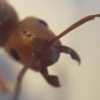The larger queen of the two queens (not pictured) I am very confident is a Lasius neoniger queen.
The other queen only had 1 wing left and ripped it off after collection. This is the smaller queen. She is the one in the test tube setup in the pictures. I think the smaller queen looks sort of like a Lasius alienus, but they aren't from this side of the world (as far as I can tell from Google). She is certainly not a Lasius neoniger, being that she is much smaller, darker coloured, and smooth/shiny. She has yellow legs as well. I can't find any information for nuptial flights for any other species in this area. I'm stumped. Please help me identify this queen



















